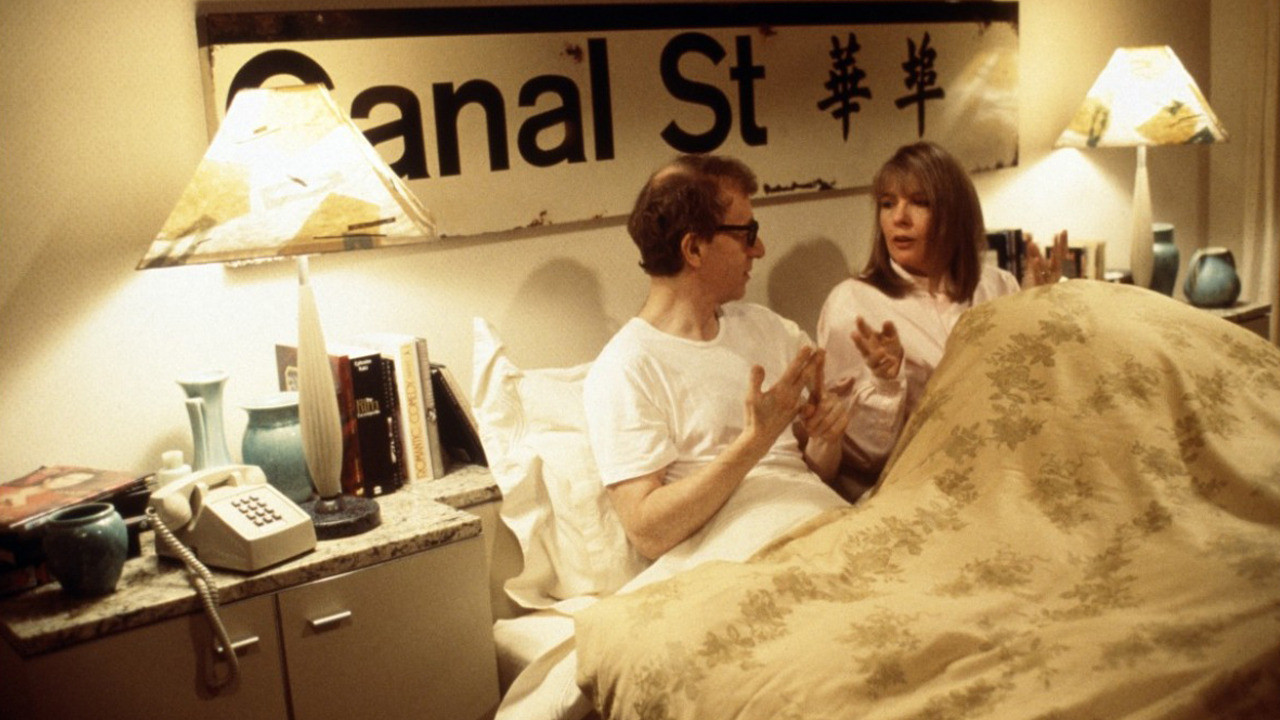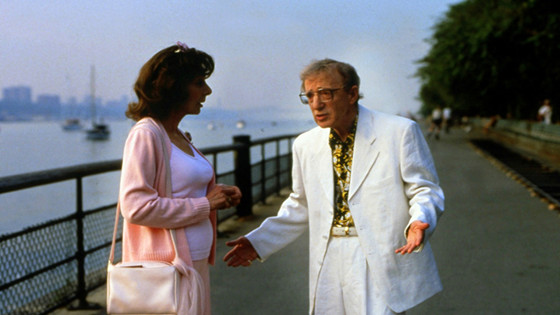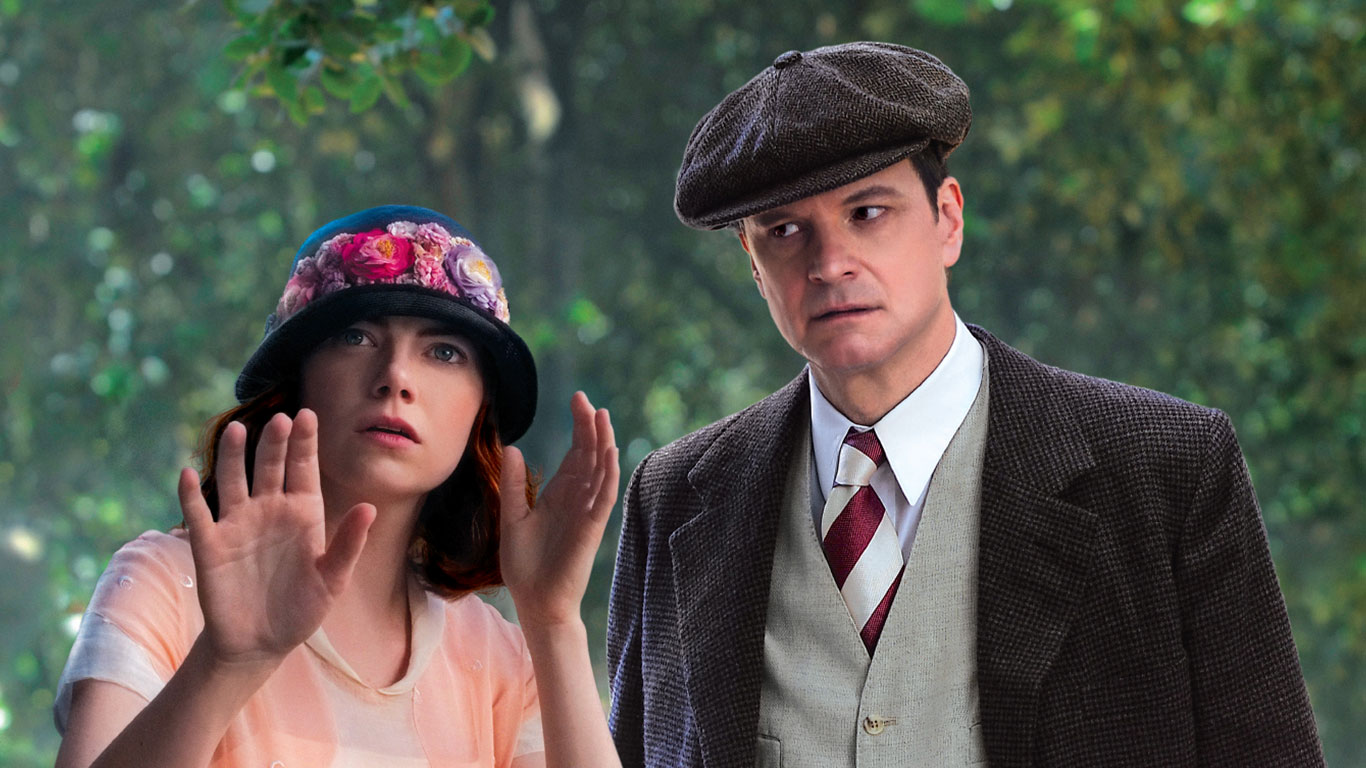6. Broadway Danny Rose (1984)
Woody’s 1983 release, Zelig, a ‘mockumentary’ about a man so eager to please others that he becomes a human chameleon, gained much favorable publicity for its use of technology in changing old historical films and pictures to fit into Allen’s story. After Zelig, Woody quickly released Broadway Danny Rose, the story of a mythical New York talent (Allen) agent who represented a rag tag group of clients.
While acting as a ‘beard’ for one of his clients, singer Lou Canova (Nick Apollo Forte), Danny falls afoul of a mobster who believe that Danny is actually the one running around with the mobster’s girlfriend, Tina (Mia Farrow). The situation eventually gets straightened out, even though Lou launches a successful singing career and kicks the ever loyal Danny to the curb, but Danny and Tina fall in love and end up together, happily ever after.
Somewhat of a return to the “early, funny films” style of Allen’s first pictures, Broadway Danny Rose nonetheless tells a humorous story that also allows for considerable pathos and character development as well. By framing his story of agent Danny Rose in the context of a discussion of ‘show biz types’ occurring in New York’s famed Carnegie Deli, Allen tells the kind of tall tale that he must have heard for many years from others older than he.
Is the story of Broadway Danny Rose actually a true story? The viewer must be somewhat skeptical of the veracity of it all, but in the end, Broadway Danny Rose is an enjoyable divertissement that shows Allen working in a relaxed environment in which he was comfortable. Though the film was not a big hit with audiences at the time, it should not be overlooked as a memorable part of the canon of the films of Woody Allen.
7. Manhattan Murder Mystery (1993)
In 1992, after a decade of making films with Mia Farrow, a scandal exploded that permanently altered the world of Woody Allen. Mia discovered that Woody had been having an affair with her adopted daughter, Soon-Yi Previn, which quickly ended their professional as well as their personal partnership.
The adverse publicity affected Woody’s status as a well known filmmaker and hindered the making of his next film, Manhattan Murder Mystery, which he intended to again be a co-starring vehicle with Mia Farrow. Into the breach stepped Allen’s old friend Diane Keaton, who took Mia’s part as Carol Lipton, wife to Woody’s Larry. The Liptons live in New York’s Greenwich Village, and they come to suspect their neighbor, Paul House (Jerry Adler) of murdering his wife, Lillian.
The Liptons pull their friend, Ted (Alan Alda) into the intrigue, and they come to believe that Paul is planning to run away with a young actress, Helen (Melanie Norris). The plot thickens when the Liptons see a woman who appears to be a double for Lillian, but they end up finding her dead body in a hotel room. Eventually the story is solved and the plot unraveled, just in time for Paul to be arrested and the plan revealed.
The making of Manhattan Murder Mystery was a welcome respite for Woody from a troubled year in which he had battled Mia in the courts and in the court of public opinion.
Unfortunately, this entertaining and interesting film was somewhat the victim of these unusual circumstances, as audiences did not seem to be in a mood to see Woody Allen cavorting around on screen while he was accused of being a child molester in real life. It’s too bad, because Manhattan Murder Mystery is a fun film to watch, and serves as an excellent homage to the films of both Alfred Hitchcock and Orson Welles.
Hitchcock is referred to by the film’s similarity to Rear Window (1954) in both the setting and the plot, and Welles is given an overt homage in a scene late in the film that recalls the famous ‘House of Mirrors’ sequence from his 1947 film noir, The Lady from Shanghai. In Manhattan Murder Mystery, Woody shows that he was influenced by more than just the European masters of film, and the results are a high quality, humorous suspense film from a director known more for his comedies and dramas.
8. Deconstructing Harry (1997)
By and large, the 1990’s were an uneven period for Allen; Bullets Over Broadway (1994) and Mighty Aphrodite (1995) were more successful with the Academy of Motion Picture Arts & Sciences than they were with the public, and other films were not popular with either.
A small gem in this period is Deconstructing Harry, released late in 1997 to an indifferent reaction from critics and audiences. Allen is Harry Block, a writer who has alienated most of the people close to him, either through his behavior or for the negative way he has written about them in thinly disguised characters.
Harry travels to his old university (somewhat like Sandy Bates in Stardust Memories) for a ceremony to give him an honorary degree, and he is depressed that he has nobody to go along with him. Eventually, he kidnaps his son, Hilliard (Eric Lloyd) for the trip, and he is also accompanied by a friendly prostitute, Cookie (Hazelle Goodman) as well as an old friend, Richard (Bob Balaban) who is in ill health.
Many problems occur for Harry, not the least of which is finally being arrested for Hilliard’s kidnapping, as well as drug and weapons charges. Harry finally realizes that he can only be happy while creating art, where he can control the ‘characters’ in his life. The film was unusual in the way it presented Woody Allen, not as the usual lovable nebbish or as a made up character, but as an unvarnished real human being full of many blemishes, not the least of which was the use of considerable foul language.
Audiences seemed to recoil from this frank look at Woody’s personal life, but the film was a courageous attempt to confront personal and professional demons that had bothered Allen for years. In the end, Deconstructing Harry was a failure as a movie, but as a film it is an interesting entry into the catalogue of Woody Allen that should be seen and appreciated for what it is: a starkly autobiographical look at a troubled soul.
9. Small Time Crooks (2000)
Woody began the new millennium with much promise, as he signed a deal with Dreamworks Pictures that offered him larger budgets than he had had in the past. His first film, Small Time Crooks, starred Woody and comedian Tracy Ullman as husband and wife Ray and Frenchy Winkler, who are planning a bank robbery while simultaneously operating a cookie shop as part of their cover.
Although the robbery fails, the cookies are a success, and by franchising the operation the Winklers become rich after all. However, the Winklers soon become the target of a shady art dealer, David (Hugh Grant), who runs off to Europe with Frenchy in order to fleece her of her fortune. When the Winkler’s fortune is lost due to a crooked accountant, David quickly dumps the now broke Frenchy, who ends up returning to Ray and the type of small time crime that the two had pursued in the past.
Small Time Crooks is the kind of intelligent, clever comedy that Allen turned out routinely for years, shot with a talented ensemble cast and featuring an entertaining story line that easily satisfied audiences. The film was moderately commercially successful and critically praised, but in the light of the success that Allen had following 2005’s Match Point, Small Time Crooks might now easily be overlooked.
It shouldn’t be, as Small Time Crooks gives one of the best examples of Woody Allen’s simple artistry. The film is a funny, amusing tale that is told efficiently and it conveys a satisfying message; simply put, it is that we are who we are and we shouldn’t try to be anything more, as in the end we cannot help but return to our roots.
10. Magic in the Moonlight (2014)
Over the last decade, Allen’s films have, for the most part, performed well at the box office, as he has seemingly been embraced by a younger generation that does not remember (or doesn’t care about) his scandalous public feud with Mia Farrow in the early 1990’s. Vicky Christina Barcelona (2008), Midnight in Paris (2010) and Blue Jasmine (2013) have all grossed close to or over $100 million at the box office, an extraordinary performance from a director whose films routinely grossed $10 million or less just a few years earlier.
His 2014 film, Magic in the Moonlight, however, did not do as well as these others, although with a box office gross of $32 million it did made back its costs. The story, though, is one of Allen’s most creative and returns to the themes of magic and illusion that had previously concerned him in the early and mid 1980’s.
Set in the 1920’s, Colin Firth plays Stanley Crawford, a world famous illusionist, who is approached by fellow illusionist Howard Burkan (Simon McBurney) to unmask a young woman named Sophie (Emma Stone) who is masquerading as a mystic. Sophie has several members of a rich American family living on the French Riviera convinced that she is a legitimate psychic who can really tell the future, but others want her discredited before she can get her hands on the family’s money.
Despite all of his efforts, Stanley cannot debunk Sophie, and he eventually even comes to believe that she is actually for real, so much so that he makes a public proclamation to that effect. In the end, Sophie’s scheme is unravelled, but by then Howard has actually developed feelings of love for the young woman, and he finally asks for her hand in marriage.
Magic in the Moonlight contains an exploration of some of Allen’s favorite themes. As a spell of magic is apparently cast by the young Sophie, she eventually weaves a spell of love as well, even as her efforts as a mystic are proven to be false. For Allen, the world of illusion in his stories often falls away, only to be replaced by the even deeper illusion of human love. Hard boiled realist or dreamy romantic…which one is he? After almost fifty years of sublime filmmaking, it is sometimes hard to tell, but one thing is clear:
Woody Allen is now an American classic. His best films are worth seeing over and over again, and even some of his less successful films (such as the ones in this list) are worth revisiting for their fine acting performances, clever writing and beautiful cinematography. At the age of 80, Woody seems to have been reborn in the eyes of a new generation, and he should be revered by us all as a contemporary master of the medium of film.
Author Bio: Jim Davidson is a 1980 graduate of Northwestern University’s Radio-TV-Film Dept. He lives in the San Francisco Bay Area and has been a video producer since 1987. Jim has written articles for Images Film journal and is currently working on a book about the movie Harold and Maude.




